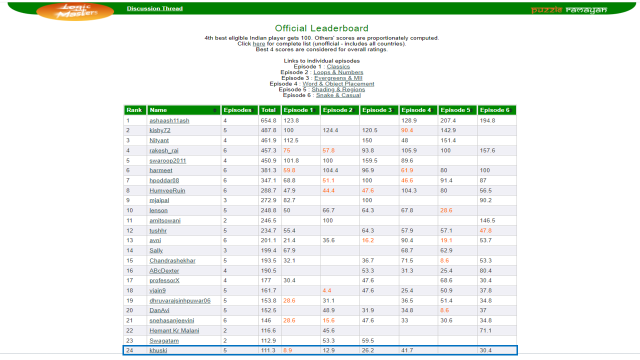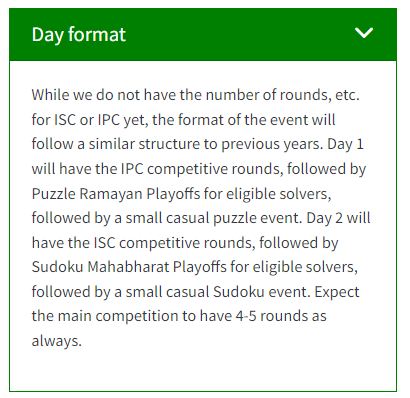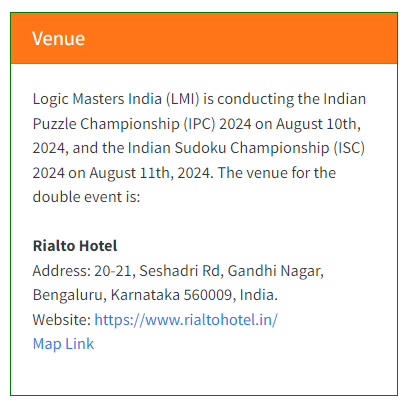
Indian Sudoku Championship is conducted by Logic Masters India
This year it was held on 28 May 23.

Took part in it for the 12th year consecutively.
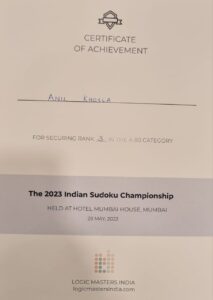
Stood third in the A-50 category.
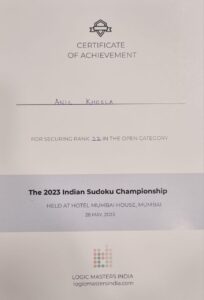
Secured an all India rank of 22 in the open category.
It was a four round gruelling competition, with about 30 odd variants of Sudoku being played.
Instructions booklet for
Sudoku Mahabharat 2023 Finals
&
Indian Sudoku Championship 2023
28th May 2023
| Finals: |
Round 1 – The Classics |
40 minutes: 400 points |
| Starts at 9:00 AM
Total Solving Time:
270 minutes Total Points: 2600 + Bonus + Base points |
|
|
| Round 2 – The Seen |
70 minutes: 700 points |
|
|
| Round 3 – And the Unseen |
90 minutes: 900 points |
|
|
| Round 4 – Two Way Relay |
70 minutes: 600 points |
Round 1
It had 10 Classic Sudokus.
| Sudoku |
Points |
| Classic Sudoku 1 |
20 points |
| Classic Sudoku 2 |
20 points |
| Classic Sudoku 3 |
30 points |
| Classic Sudoku 4 |
25 points |
| Classic Sudoku 5 |
30 points |
| Classic Sudoku 6 |
30 points |
| Classic Sudoku 7 |
40 points |
| Classic Sudoku 8 |
55 points |
| Classic Sudoku 9 |
50 points |
| Classic Sudoku 10 |
100 points |
(1-10). Classic Sudoku (20+20+30+25+30+30+40+55+50+100 points)
Place a digit from 1 to 9 in each empty cell so that each digit appears exactly once in each row, column and 3×3 box.
Round 2
It had ten sudoku variants representing some of the online rounds of Sudoku Mahabharat 2023.
| Variant |
Points |
| Outside Sudoku |
45 points |
| Pointing Evens Sudoku |
50 points |
| Killer Sudoku |
55 points |
| Thermo Sudoku |
55 points |
| Position Sums Sudoku |
100 points |
| No Three in a Row Sudoku |
80 points |
| Skyscrapers Sudoku |
75 points |
| Hex Sudoku |
75 points |
| XV Sudoku |
120 points |
| Pencil marks Sudoku |
40 points |
1. Outside Sudoku (45 points)
Apply classic Sudoku rules. Additionally, the digits outside the grid must appear in one of the cells in the first box (till the next bold line) seen from that edge of the grid
2. Pointing Evens Sudoku (50 points)
Apply classic Sudoku rules. Digits outside the grid indicate the number of evendigits in the direction of the arrow.
3. Killer Sudoku (55 points)
Apply classic Sudoku rules. Additionally, the sum of digits in cells inside everycage must equal the total given for the cage at the upper left cell. Digits do not repeat inside a cage.
4. Thermo Sudoku (55 points)
Apply classic Sudoku rules. Digits along each thermometer are strictly increasing from its bulb to each of its ends.
5. Position Sums (100 points)
Apply classic Sudoku rules. Digits in the first and second cell from the top and from the left are A and B for that column/row. There are two sets of clues outside the grid: The ones closest to the grid give the sum of A and B. The ones further out give the sum of the digits in the Ath and Bth positions in that direction.
6. No Three in a Row Sudoku (80 points)
Apply classic Sudoku rules. Digits in any three consecutive cells in any row or column must not be of the same parity.
7. Skyscrapers Sudoku (75 points)
Apply classic Sudoku rules. Each digit inside the grid represents the height of a skyscraper in that cell. Each number outside the grid represents the number of skyscrapers that can be seen in that row or column. Taller skyscrapers hide shorter ones.
8. Hex Sudoku (75 points)
Apply classic Sudoku rules. Digits do not repeat along any of the three directions in which the hexagonalcells share edges of a line.
9. XV Sudoku (125 points)
Apply classic Sudoku rules. Adjacent cells with digits summing to 5 are marked by V. Adjacent cellswith digits summing to 10 are markedby X. All possible V and X are marked.
10. Pencilmarks Sudoku (40 points)
Apply classic Sudoku rules. Additionally, in some cells you find all allowed candidates for the specific cell.
Round 3
It had ten sudoku variants which are seen less frequently in competitions.
| Variant |
Points |
| Confetti Sums Sudoku |
55 points |
| First Seen Odd/Even Sudoku |
55 points |
| Position Sudoku |
50 points |
| Slanted Killer Cages Sudoku |
115 points |
| Nine Pins Sudoku |
95 points |
| Mathrax Sudoku |
70 points |
| Max Ascending Sudoku |
100 points |
| Quad Sums Sudoku |
80 points |
| Rossini Sudoku |
110 points |
| Arrow or Thermo Sudoku |
170 points |
1. Confetti Sums Sudoku (55 points)
Apply classic Sudoku rules. All pairs of digits having sums of A, B and C are marked with circles of white, grey, and black colors respectively. A, B and C have different values and need to be determined as part of solving.
2. First Seen Odd/Even Sudoku (55 points)
Apply classic Sudoku rules. Clues adjacent to a row or column give the first odd (if the clue is odd) or first even(if the clue is even) digit in that row or column from the direction of the clue.
3.Position Sudoku (50 points)
Apply classic Sudoku rules. Numbers outside the grid indicate the position of the largest digit in the first three cells.
4. Slanted Killer Cages Sudoku (115 points)
Apply classic Sudoku rules. Digits in cages must sum to the given total and must not repeat. Digits in cells containing diagonal lines contribute half their value to the total of the cage and may belong to more than one cage.
5. Nine Pins Sudoku (95 points)
Apply classic Sudoku rules. Each digit from 1 to 9 must form a diagonal triplet (three of same digit along a diagonal line) at least once.
6. Mathrax Sudoku (70 points)
Apply classic Sudoku rules. Some intersections of the grid lines are marked by a number and an operator (+, -, X, /) in a circle. The number is the result of the operation, applied to both pairs of diagonally opposite cells. An “E” in the circle indicates that all four adjacent digits are even; an “O” indicates that all four adjacent digits are odd.
7. Max Ascending Sudoku (100 points)
Apply classic Sudoku rules. Each clue adjacent to a row or column gives the exact length of the longest contiguous run of increasing digits within that row or that column, counting from the direction of the clue.
8. Quad Sums Sudoku (80 points)
Apply classic Sudoku rules. A dot at a corner implies that one digit is the sum of the remaining three digits at that corner. Not all dots are given.
9. Rossini Sudoku (110 points)
Apply classic Sudoku rules. Each arrow outside the grid indicates that the digits within the first box (till the next bold line) in the corresponding direction are in ascending order in the direction of the arrow. All such arrows are marked.
10. Arrow or Thermo Sudoku (170 points)
Apply classic Sudoku rules. Each line is either a Thermo from the given bulb, or an Arrow with the given head. Exactly half of the lines are Thermos and half are Arrows.
Arrow Sudoku: Digits in the circled cells must be the sum of the digits along the arrow pointing out of it. Digits can repeat on the arrow.
Thermo Sudoku: Digits along each thermometer are strictly increasing from its bulb to each of its ends.
Round 4
General rules:
| · This round consists of 9 puzzles, 3 Classic Sudokus and 6 Sudoku Variants. The first and last puzzle are solvable by themselves.
· In other puzzles, there are some arrows.
· The digit from the same cell from the previous sudoku should be transferred to the downward- pointing arrow.
· The digit from the same cell from the next sudoku should be transferred to the upward-pointing arrow.
· Some sudokus may have multiple solutions but the complete round can be solved in only one way.
· Partial points will be givenonly for every correct grid which is part of the complete solution.
· Points will be awarded based on the number of sudokus solved correctly as part of the overall solution. |
|
| Variant |
Points |
| 1 Sudoku |
30 points |
| 2 Sudokus |
90 points |
| 3 Sudokus |
150 points |
| 4 Sudokus |
220 points |
| 5 Sudokus |
290 points |
| 6 Sudokus |
360 points |
| 7 Sudokus |
440 points |
| 8 Sudokus |
520 points |
| 9 Sudokus |
600 points |
1,4,7. Classic Sudoku
Refer to rules and example in round 1.
2. Irregular Sudoku
Place a digit from 1 to 9 in each empty cell so that each digit appears exactly once in each row, column and each outlined region.
3. Product Frame Sudoku
Apply classic Sudoku rules. Numbers outside the grid equal the product of the first three numbers in the corresponding row or column in the given direction.
5. Palindrome
Apply classic Sudoku rules. The digits in the cells with the line form palindromes, i.e. they read the same from both the directions.
6. Sandwich
Apply classic Sudoku rules. Numbers outside the grid indicate the sum of digits between 1 and 9 in the corresponding row or column.
8. Slot Machine
Apply classic Sudoku rules. The three shaded columns are like a slot machine. The 9 numbers they contain will be in the same sequence. (The strips wrap around the grid for the ordering)
9. Clone Sudoku
Apply classic Sudoku rules. Digits in each corresponding cell in the shaded figures are identical.
Suggestions and value additions are most welcome
For regular updates, please register here
Subscribe
References and credits
To all the online sites and channels.
Disclaimer:
Information and data included in the blog are for educational & non-commercial purposes only and have been carefully adapted, excerpted, or edited from sources deemed reliable and accurate. All copyrighted material belongs to respective owners and is provided only for purposes of wider dissemination.




